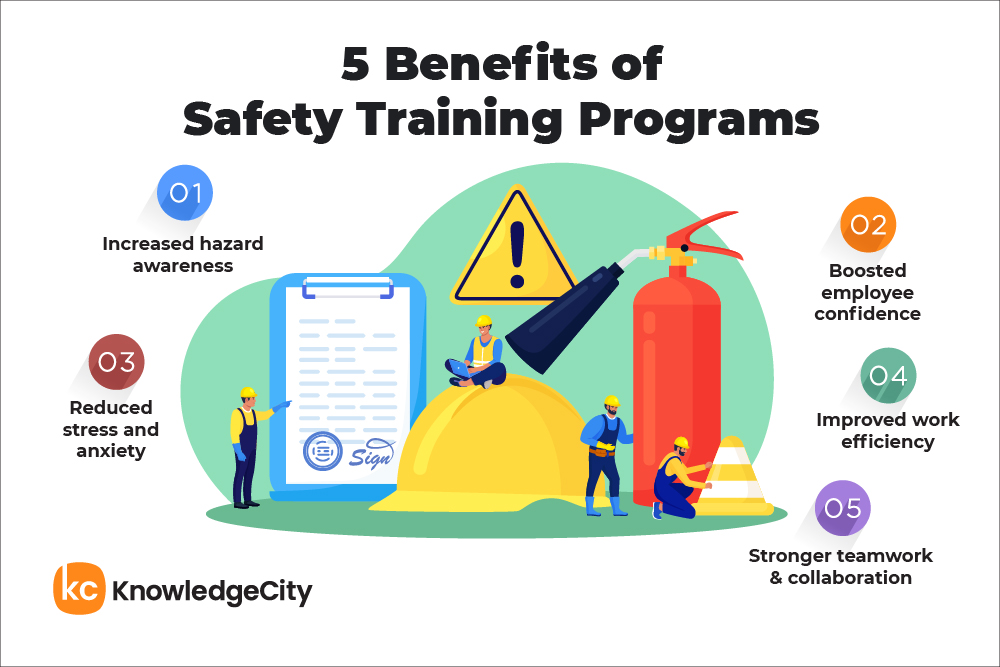A safe work environment isn’t just a perk; it’s a basic right for every employee. Achieving this requires taking action. A solid organization is built on a safe and healthy workplace. Unfortunately, accidents can happen in any industry. The good news? Proactive safety training programs can greatly reduce these risks. By giving your team the tools to identify, avoid, and handle potential dangers, you’re not just keeping them healthy—you’re building a safety-focused culture.
In this article, we’ll discuss how safety training empowers employees to prevent accidents, injuries, and illnesses. Investing in safety training helps businesses promote well-being and enjoy the benefits of a healthier, happier, and more productive workforce.

The Importance of a Safe Work Environment
A safe work environment isn’t just about meeting regulations or avoiding minor injuries. It’s about creating a place where employees feel secure and appreciated. Safety at work leads to fewer accidents and injuries, cutting down on costs like medical care, lost workdays, and retraining. Here are a few reasons why having a safe workplace matters:
- The Foundation for Flourishing: Why Workplace Safety Matters
A safe work environment goes beyond simply following regulations or preventing minor mishaps. It forms the bedrock for a thriving workforce and a successful company. By instilling a sense of security in your employees, you can directly boost their morale and productivity.
- From Anxious to Engaged: The Well-Being Effect
Consider a workplace where employees live in a constant state of anxiety, always concerned about potential hazards or unclear safety protocols. This sort of ongoing, chronic stress can affect their focus, productivity, and attendance. In fact, according to the American Institute of Stress, depression-related absenteeism resulting from chronic stress costs businesses $51 billion annually. In contrast, a safe environment enhances employee well-being. Employees can feel confident knowing their health and safety come first at work. This reduces stress, allowing them to focus their energy on productive tasks.
- Beyond Band-Aids: The Financial Advantage
By prioritizing employee safety, your organization also saves itself money in the long-term. Accidents and injuries translate to major medical expenses, higher insurance premiums, and more time lost to illness and absenteeism. A safe work environment significantly cuts these costs, enhancing the company’s profitability. It also reduces the risk of legal consequences for failing to comply with federal safety regulations.
- A Culture of Care: Building Trust and Loyalty
Safety goes beyond checklists; it’s about building a culture of care. When a company prioritizes employee well-being and invests in creating a safe environment, it sends a powerful message. Employees feel valued and respected, strengthening their trust and loyalty. This leads to a more stable workforce with lower turnover rates, enabling the company to retain valuable talent and experience.
How Can Training Programs Benefit You?
According to a recent survey by Intertek Alchemy, verifying the effectiveness of safety training programs is among the biggest challenges in establishing workplace safety. Training programs serve as an important tool, providing employees with the knowledge and skills for navigating the work environment safely and confidently. These programs offer numerous benefits beyond just injury prevention:
- Increased Awareness: Training programs shed light on any potential hazards that may have gone unnoticed. They educate employees about specific risks associated with their roles and the overall work environment, enabling them to prevent dangerous situations by recognizing them in advance.
- Enhanced Confidence: Acquiring new skills to manage potential hazards can instill a sense of confidence in your employees. Safety training empowers them to respond effectively in emergencies and take a composed approach to their daily tasks.
- Reduced Stress and Anxiety: Safety training dispels uncertainty by providing clear information about risks and mitigation strategies. This relieves stress and anxiety, allowing employees to concentrate on their work without worrying about potential dangers.
- Improved Efficiency: When employees are confident in their ability to navigate the work environment safely, they can focus on completing tasks efficiently. Safety training often includes procedures for using equipment and tools, streamlining workflows and saving time.
- Strengthened Teamwork and Collaboration: By including interactive elements and group discussions as part of the curriculum, your safety training can promote the responsibility everyone shares for maintaining a safe work environment. By collaborating to identify and address potential hazards, teams develop stronger communication and collaboration skills.
Investing in safety training programs is an investment in employees. It empowers them with the knowledge and skills to protect themselves and those around them, ultimately creating a more positive and productive work experience for everyone.
Types of Safety Training Programs
To effectively address workplace risks, a tailored approach is essential. Here are various types of safety training programs:
- General Safety Training: This foundational training provides a broad overview of safety procedures that apply across most workplaces. Common topics include fire safety, first aid, emergency evacuation protocols, and basic hazard identification.
- Industry-Specific Training: Certain industries have unique risks. These programs delve deeper into the specific hazards associated with a particular field. For example, construction workers might receive training on proper use of heavy machinery and fall prevention techniques, while healthcare professionals might focus on bloodborne pathogen exposure and safe patient handling.
- Job-Specific Training: Job-specific training equips employees with role-specific knowledge and skills. For example, lab technicians learn chemical handling safety, while office workers receive ergonomic training to prevent injuries from repetitive hand movements.
- Hazard Communication Training: This training focuses on understanding the dangers posed by hazardous materials in the workplace. Employees learn how to identify and classify these materials, how to interpret safety data sheets (SDS), and how to follow proper handling and storage procedures.
- Emergency Response Training: Preparation for unexpected events is vital. Emergency response training teaches employees how to respond effectively in emergencies like fires, chemical spills, or medical emergencies.
- Behavioral Safety Training: Safety isn’t just about knowing the rules; it’s about cultivating a safety mindset. Behavioral safety training programs focus on how to identify unsafe behaviors that could lead to accidents or injuries.
These are just a few examples, and the specific type of safety training program you offer depends on your workplace. But all safety training programs share the common goal of establishing a safe and healthy work environment for everyone.
How to Create Your Safety Training Program
An effective safety training program is the cornerstone of a safe work environment. Here’s a step-by-step guide to crafting your own successful program:
- Assess Your Needs:
- Identify Hazards: Begin by conducting a comprehensive risk assessment of your workplace. This involves identifying potential hazards related to your industry, equipment, and work processes. Engage with employees, review accident reports, and observe daily operations to pinpoint areas of concern.
- Understand Regulations: Familiarize yourself with relevant safety regulations imposed by your industry or local authorities. These regulations establish the minimum safety standards that your training program must adhere to.
- Gauge Employee Knowledge: Evaluate the current level of safety awareness among your employees. This can be achieved through surveys, interviews, or pre-training assessments. Identifying their knowledge gaps will help you customize the training program to address that specific knowledge.
- Define Your Learning Objectives:
- Clarify Training Goals: Clearly define what you aim to achieve with your employee safety training program. Use a structured approach to ensure objectives are clear, quantifiable, feasible, pertinent, and time-sensitive.
- Focus on Outcomes: Instead of solely transferring information, emphasize the desired results. Do you want employees to identify hazards, follow specific procedures, or demonstrate emergency response skills?
- Choose the Right Delivery Method:
- Variety Is Key: Adult learners benefit from a diverse range of training methods. Consider incorporating lectures, interactive workshops, hands-on demonstrations, and video presentations to keep your program engaging.
- Accessibility Matters: Ensure all employees can access the training program. This might involve offering training materials in multiple languages or providing alternative formats for employees with disabilities.
- Technology Integration: Explore incorporating online learning modules or gamification elements to enhance engagement and cater to different learning styles.
- Develop Engaging Content:
- Keep It Relevant: Concentrate on practical situations and risks that apply to your employees’ daily tasks. Use straightforward, succinct language and refrain from overwhelming participants with too much information at once.
- Make It Interactive: Integrate activities, discussions, and case studies into your training to promote active learning and involvement. This reinforces comprehension and cultivates employees’ critical thinking skills.
- Utilize Visuals: Employ images, videos, and infographics to improve understanding and elevate the learning experience’s appeal.
- Visual Appeal Matters: Use images, videos, and infographics to make your training more engaging and easier to understand.
- Implement and Evaluate:
- Schedule Training Effectively: Select training times that minimize disruptions to your employees’ workflow. Consider offering the program in smaller modules or during non-peak hours.
- Post-Training Reinforcement: Offer ongoing safety reminders and resources following the training session. This could involve distributing posters, safety checklists, or providing access to online safety manuals.
- Evaluation is Key: Assess the effectiveness of your training program through post-training evaluations, observing employee behavior, and analyzing accident data. Use this feedback to refine and enhance your program for future iterations.
Creating a Safer Workplace with KnowledgeCity
Remember, developing a successful safety training program is an ongoing process. By regularly evaluating and updating your program, you can be sure it remains relevant and effective as you continue promoting a safety-conscious culture within your organization.
Subscribe to Our Newsletter
Join 80,000+ Fellow HR Professionals. Get expert recruiting and training tips straight
to your inbox, and become a better HR manager.

 KnowledgeCity
KnowledgeCity 











